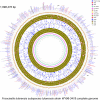Complete genomic characterization of a pathogenic A.II strain of Francisella tularensis subspecies tularensis
- PMID: 17895988
- PMCID: PMC1978527
- DOI: 10.1371/journal.pone.0000947
Complete genomic characterization of a pathogenic A.II strain of Francisella tularensis subspecies tularensis
Abstract
Francisella tularensis is the causative agent of tularemia, which is a highly lethal disease from nature and potentially from a biological weapon. This species contains four recognized subspecies including the North American endemic F. tularensis subsp. tularensis (type A), whose genetic diversity is correlated with its geographic distribution including a major population subdivision referred to as A.I and A.II. The biological significance of the A.I - A.II genetic differentiation is unknown, though there are suggestive ecological and epidemiological correlations. In order to understand the differentiation at the genomic level, we have determined the complete sequence of an A.II strain (WY96-3418) and compared it to the genome of Schu S4 from the A.I population. We find that this A.II genome is 1,898,476 bp in size with 1,820 genes, 1,303 of which code for proteins. While extensive genomic variation exists between "WY96" and Schu S4, there is only one whole gene difference. This one gene difference is a hypothetical protein of unknown function. In contrast, there are numerous SNPs (3,367), small indels (1,015), IS element differences (7) and large chromosomal rearrangements (31), including both inversions and translocations. The rearrangement borders are frequently associated with IS elements, which would facilitate intragenomic recombination events. The pathogenicity island duplicated regions (DR1 and DR2) are essentially identical in WY96 but vary relative to Schu S4 at 60 nucleotide positions. Other potential virulence-associated genes (231) varied at 559 nucleotide positions, including 357 non-synonymous changes. Molecular clock estimates for the divergence time between A.I and A.II genomes for different chromosomal regions ranged from 866 to 2131 years before present. This paper is the first complete genomic characterization of a member of the A.II clade of Francisella tularensis subsp. tularensis.
Conflict of interest statement
Figures




References
-
- Harris S. Japanese biological warfare research on humans: a case study of microbiology and ethics. Ann N Y Acad Sci. 1992;666:21–52. - PubMed
-
- Harris S. Japanese biological warfare experiments and other atrocities in Manchuria, 1932–1945, and the subsequent United States cover up: a preliminary assessment. Crime, Law and Social Change. 1991;15:171–199.
-
- Dennis DT, Inglesby TV, Henderson DA, Bartlett JG, Ascher MS, et al. Tularemia as a biological weapon: medical and public health management. Jama. 2001;285:2763–2773. - PubMed
-
- CDC. Key Facts About Tularemia. 2003 http://www.bt.cdc.gov/agent/tularemia/pdf/tularemiafacts.pdf.
Publication types
MeSH terms
Substances
Grants and funding
LinkOut - more resources
Full Text Sources
Other Literature Sources
Molecular Biology Databases

